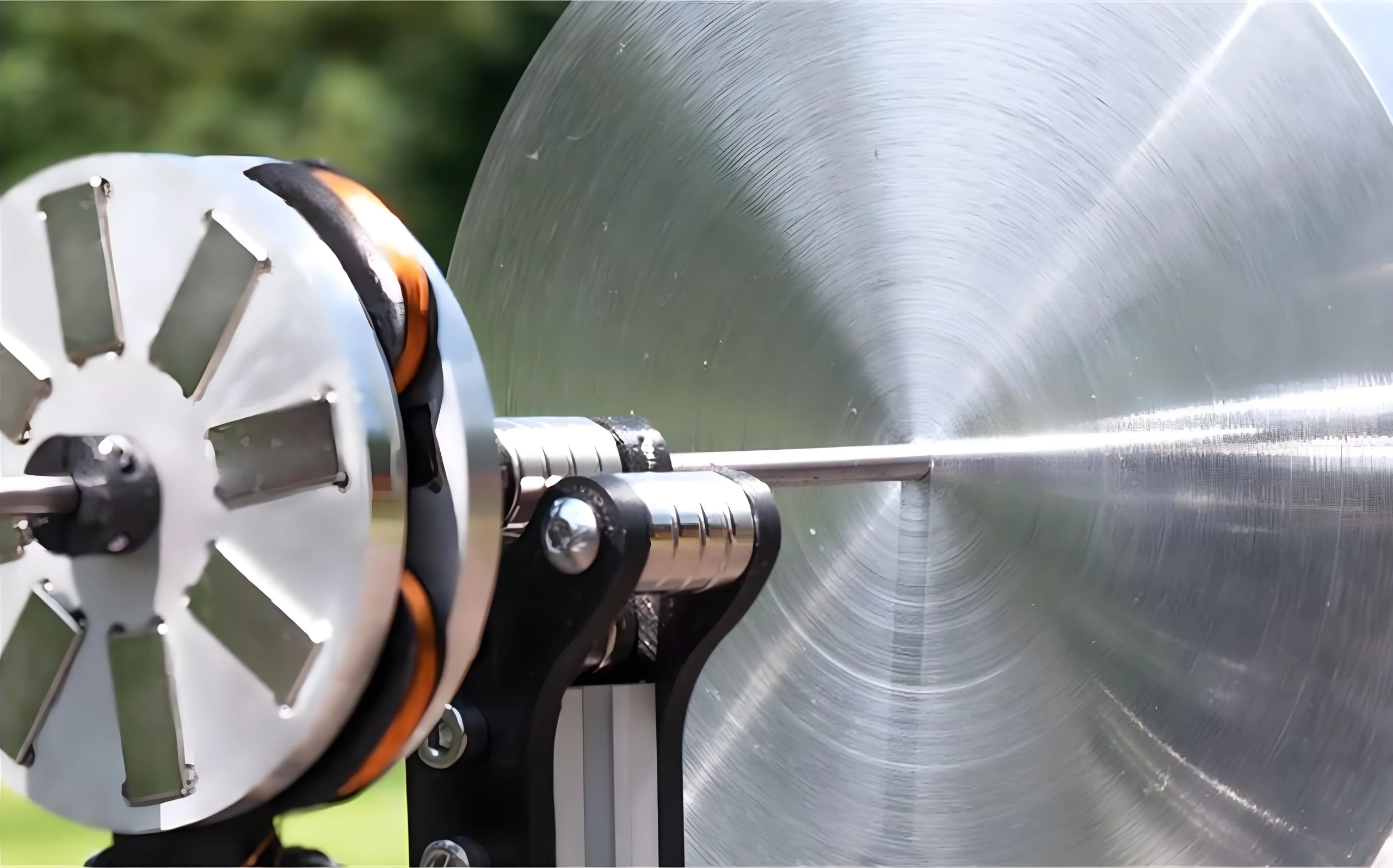Photovoltaic projects have developed rapidly in recent years, which have liberated traditional fuel power plants and reduced the pressure on public power grids. Wind and solar energy have brought us powerful and almost eternal energy. How to flexibly store, control and use this energy has become the key. This article will explain the flywheel energy storage system (FESS). You can learn about its working principle, advantages and disadvantages And the comparison with BESS in the article to help you choose.
What Is a Flywheel Energy Storage System?
A flywheel energy storage system is a mechanical device used to store energy through rotational motion. When excess electricity is available, it is used to accelerate a flywheel to a very high speed. The energy is stored as kinetic energy and can be retrieved by slowing down the flywheel, converting the motion back into electricity.
How Does a Flywheel Energy Storage System Work?
To understand how a flywheel energy storage system works, imagine a figure skater performing a spin. When the skater pulls their arms in, they spin faster, storing rotational energy. When they extend their arms, the spin slows down. The skater’s body is like the flywheel, and their spinning motion represents the stored energy.
In a flywheel energy storage system, electrical energy is used to spin a flywheel at incredibly high speeds. The flywheel, made of durable materials like composite carbon fiber, stores energy in the form of rotational kinetic energy. Here’s a breakdown of the process:
- Energy Absorption: When there’s surplus electricity, such as when the grid is overproducing energy, the system uses that excess power to accelerate the flywheel. This energy is stored as kinetic energy, much like how the figure skater speeds up their spin by pulling in their arms.
- Energy Storage: The flywheel continues to spin at high speed, maintaining energy as long as friction and resistance are minimized. The longer it spins, the more energy it holds, similar to how the skater retains rotational energy as they keep spinning.
- Energy Release: When the system needs power—such as during a peak demand or grid fluctuation—the flywheel’s rotation is slowed down. The process of decelerating the flywheel converts the stored kinetic energy back into electricity, which can be fed into the grid or used by other devices. This process works much like the figure skater releasing their arms to slow down, transferring that energy into a new motion.
In essence, a flywheel stores and releases energy just like a figure skater harnessing and controlling their spinning momentum, offering fast, efficient, and long-lasting energy storage.
Components of a Flywheel Energy Storage System
- Flywheel: The core of the system, typically made of composite materials, rotates at very high speeds.
- Motor/Generator: This component drives the flywheel and also converts the kinetic energy back into electricity.
- Bearings: Advanced bearings help reduce friction, allowing the flywheel to maintain its speed.
- Power Electronics: These regulate the flow of electricity in and out of the system.
Advantages of Flywheel Energy Storage Systems
Flywheel systems have several advantages, particularly in applications requiring fast charge and discharge cycles.
- Rapid Charge/Discharge: Flywheels can charge and discharge electricity much faster than traditional batteries, making them ideal for balancing power grids or managing short-term fluctuations in energy demand.
- Long Lifespan: With no chemical reactions involved, flywheels can last for tens of thousands of cycles, significantly outperforming batteries in terms of longevity.
- High Efficiency: Flywheel systems are highly efficient at storing and releasing energy, with minimal energy loss over time.
- Environmentally Friendly: Since there are no harmful chemicals or heavy metals involved, flywheels are considered a greener option compared to chemical batteries.
Flywheel Energy Storage vs. Battery Storage
While both flywheel and battery storage systems serve the same fundamental purpose—storing energy for later use—their technologies, performance characteristics, and best-use scenarios are quite different.
| Feature | Flywheel Energy Storage | Battery Energy Storage |
| Energy Storage Mechanism | Kinetic energy via spinning flywheel | Chemical reactions within battery cells |
| Charge/Discharge Time | Very fast, typically under 10 seconds | Slower, usually takes minutes to hours |
| Efficiency | High, with minimal energy loss | Good, but loses some energy over time |
| Lifespan | Tens of thousands of cycles | Generally shorter, around 3,000-5,000 cycles |
| Environmental Impact | Low impact, no hazardous materials | Potential environmental concerns (e.g., lithium mining) |
| Cost | Higher upfront, but long-term savings | More affordable upfront, but shorter lifespan and higher maintenance costs |
What Are the Key Differences Between Flywheel and Battery Energy Storage?
- Storage Medium: Flywheels store energy in the form of kinetic energy, whereas batteries store energy chemically.
- Energy Efficiency: Flywheel systems typically offer better efficiency in terms of energy retrieval and discharge.
- Lifespan: Flywheels tend to last much longer than batteries, especially for high-cycle applications.
- Suitability for Short-Term Energy Needs: Flywheels excel in managing short-term energy surges or imbalances, while batteries are often better for long-term storage.
Which Is Better: Flywheel or Battery Energy Storage?
Both technologies have their merits, but the choice between a flywheel or a battery energy storage system largely depends on your needs:
- Flywheel Systems are more suited for applications that require rapid energy bursts, such as power grid stabilization, frequency regulation, and backup power for critical infrastructure.
- Battery Storage is typically a better choice for long-term energy storage, such as for renewable energy systems (solar or wind) or home energy storage.
Current State and Future of Flywheel Energy Storage
Flywheel technology is evolving, with several countries, including China, leading the way in large-scale flywheel installations. In 2022, China unveiled its first self-owned megawatt-scale flywheel storage system, marking a significant milestone in the development of this technology.
As the technology matures, flywheel systems are expected to play a key role in balancing power supply and integrating renewable energy sources into the grid. With decreasing costs, increased efficiency, and expanded applications, the future of flywheel energy storage looks promising.
Conclusion
Flywheel energy storage systems offer a unique and efficient alternative to traditional battery systems, with advantages in speed, lifespan, and environmental impact. While battery storage remains the dominant choice for long-term energy storage, flywheel systems are well-suited for applications requiring rapid energy release and frequent cycling. As technology continues to improve, flywheel energy storage may become a crucial component in the energy landscape, helping to support a more sustainable and resilient power grid.
Save Money, Protect Environment
PKNERGY helps you reduce your energy bills for your home solar energy storage, store your solar energy for use anytime- at night or during an outage.





